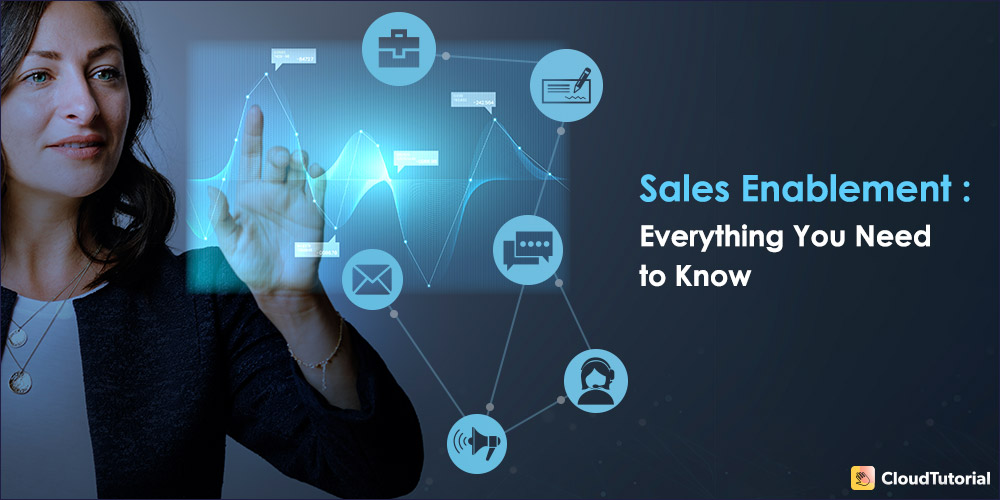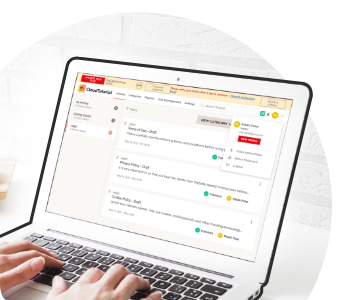Is your business failing to meet sales goals? Are you struggling to attract more clients? Has it become harder to close sales deals? Maybe your old techniques aren’t working anymore.
Fret not, as we dive into an intelligent strategy, widely known as sales enablement, that has been proven to bring in enormous results and increase your business’ profit.
By the end of this article, you will have an answer on what is sales enablement and a clear understanding of how this effective strategy can improve sales and conversion in any business.
For now, let’s take a look at what it is.
Table of Content
What is Sales Enablement Definition
Sales Enablement is a core technology that is implemented in many modern businesses today. It can be defined as provisioning or equipping the sales team of your business with specific tools, information, techniques, strategies, and resources to attract clients and close more sales deals.
It is an ongoing and strategic technique that empowers sales professionals to create better customer relations by systematically spending their time and effort.
Sales enablement has been revolutionary in bringing a change in the way companies approach sales.
It has been found that organizations adopting sales enablement have found a 10-15% more increase in their sales, with about 40% of companies claiming there is at least a 25% increase in revenue.
This clearly outlines the importance of sales enablement.
Sales enablement not only brings in profit to the business but vastly improves the productivity of the sales team by focusing their effort on selling.
Being a multi-dimensional technique, sales enablement requires the input of several different teams and professionals to create a collaborative and input-driven focus on customer acquisition and robust sales growth.
Sales Enablement Examples
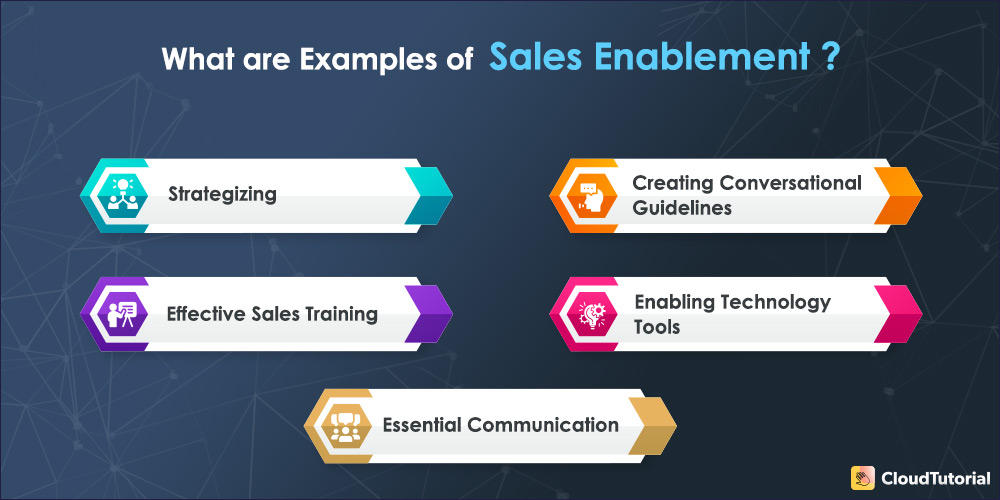
Some of the examples of sales enablement resources include content such as blog posts, email campaigns, case studies, and testimonials. These are just some of the tools used by sales enablement professionals to convert leads to sales.
Some of the ways sales enablement is highlighted in an organization include:
Strategizing
Defining the clear need for sales enablement and detailing what problems can be solved with sales enablement. Having a long-term vision to achieve business milestones and goals by utilizing specific tools, and deciding on roles and responsibilities of the team.
Creating Conversational Guidelines
Better equip the sales reps with conversational guides and optimized sales pitches to communicate effectively with the client and meet high conversion rates by offering high quality and engaging information.
Effective Sales Training
Training and coaching sales reps and the entire sales enablement team to deliver effective messages to clients and teaching them to personalize their company branding for different customers.
Enabling Technology Tools
Using technology to track customer interactions and engagement with unique brand content delivered to better gauge their behaviour and further actions.
Essential Communication
Creating a clear-cut line of communication with the different facets including sales, marketing, and the different members of the sales enablement team, leading to fruitful collaboration efforts.
Why is Sales Enablement Important?
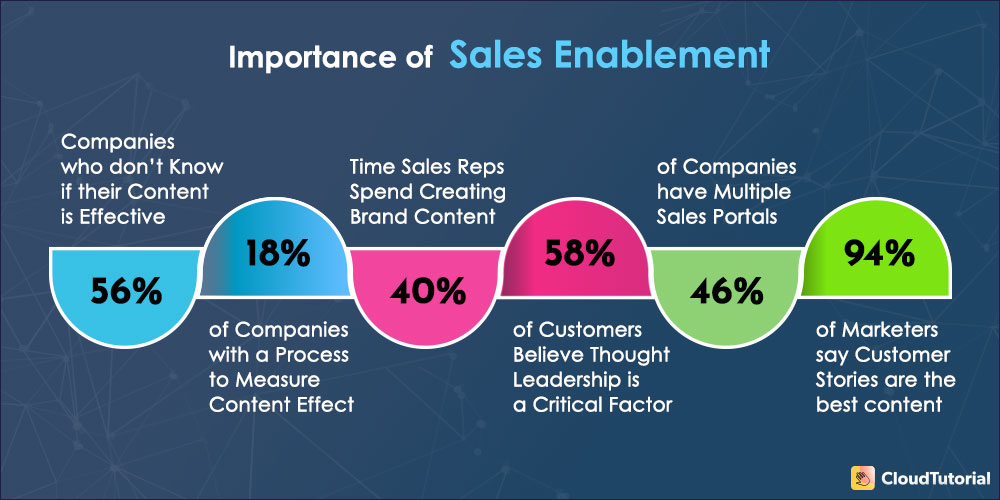
It’s important to understand the benefit of such a strategy in the modern world today. With more and more businesses opening up every day and most traditional businesses now trying to make their presence online, these businesses must use such sales techniques to their benefit.
Traditional sales pitching has had to undergo a lot of amends as customers now like to feel that business solutions are customized to their specific needs. Long gone are the days when long sales calls via telephone described the features of a product to an endless array of customers.
Customers are more aware and awake to the challenges of the world and the possible solutions to such problems. They are constantly looking to join hands with professionals who are knowledgeable and insightful and provide the value they are looking for.
Hence trying to onboard clients requires a range of strategy and data analysis.
Sales enablement makes it easier to know which leads are worth pursuing to convert and which leads might need a slightly different approach. Using the methods under sales enablement, clarity can be obtained on a lot of this forefront.
Due to the constant learning and training opportunities that sales enablement provides, this leads to the next benefit which is sales retention. Professionals that are exposed to a continuous growth environment find more fulfillment in their jobs which translates to lesser sales exits.
Organizations that adopt sales enablement strategies see benefits such as:
Acquiring Clients
Sales enablement techniques empower organizations to acquire new clients and provide recurring clients with better value.
Improving Sales Capability
Sales professionals, thanks to sales enablement, are now better equipped to build better customer relations eventually leading to better sales.
Revenue Surge
The main focus of sales enablement is to improve the revenue of an organization. All businesses focus mainly on generating more profit every step of the way and sales enablement is a suitable choice for boosting sales metrics of the company.
Collaborative Work
One of the biggest benefits of sales enablement is the contribution of both marketing and sales, two divisions that cannot work mutually exclusively.
Sales Enablement Framework
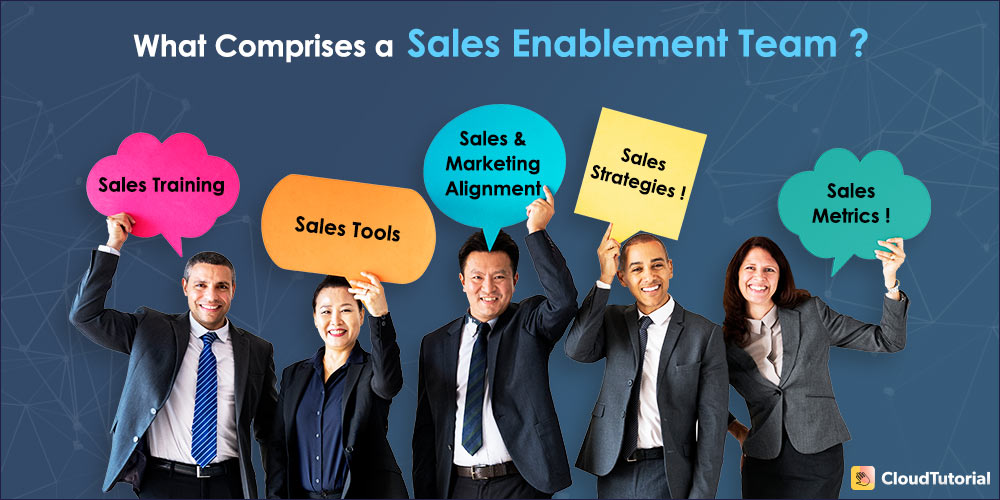
Who is Responsible for Sales Enablement?
Sales enablement is driven by both sales and marketing in most modern business organizations. Their cohesive interaction and involvement are crucial in building a specific and targeted strategy.
Marketing is most suitable and responsible for building up the immense wealth of resources and the information that sales may require. As coaching and guidance have been proven to increase sales performance, the resources provided by the marketing team can include sales training, conversational guides, and interactive content.
While marketing trains the sales organization, sales are responsible to introduce the resources provided by marketing into their daily operation. Ultimately the sales department must put the sales enablement practices into action but both teams must collaborate for proper outcomes.
As a business owner, if you find yourself struggling to clearly define the sales enablement ownership hierarchy, then the RACI framework may be of help to you.
In the RACI framework, roles and responsibilities are allocated as follows:
- R – Responsible: Sales enablement manager
- A – Accountable: Sales Enablement or Marketing VP
- C – Consulted: Sales VP, sales operations and content creators,
- I – Informed: The rest of the sales enablement team, sales reps, and other marketers
This is a common way of defining responsibilities. Since these are not set in stone, they can be switched up as sales enablement strategies are put in place and some obvious changes are noticed. But this gives you a rough idea of how to effectively divide roles and responsibilities.
What are the Elements of a Sales Enablement Team?
Planning and Strategy
This is one of the most important steps in implementing any new business tactic. Poor strategy and planning lead to the failure of all the techniques that follow.
During the planning phase, an organization can perform a complete audit and internal review of the sales process, understanding what works and what needs improvement. This audit can be based on sales reports and logs and hence will be highly data-driven.
It is also likely to identify potential leads during the planning stage itself. This could be based on a scoring system where a positive score means the client is worth pursuing and a negative score could indicate both that the client may not be a target prospect or that more time may be required to convert this prospect.
This way the process is streamlined and more time is dedicated to high-conversion leads.
Technology and Automation
Technological advancements have made sales enablement much easier than before. No longer is sales a manual effort and every single task can be automated and analyzed from setting email triggers to inspecting the performance of each email.
From a plethora of options, tools such as CRM software can direct potential customers to reps based on their online interactions.
Similarly, tools like HubSpot, Zendesk, Highspot, etc are equipped for sales enablement, integration to CRM, and automation tools for marketing.
As mentioned before, creating email sequences and automating this process can help reps trigger emails to clients that haven’t responded yet and keep a track of the number of emails sent and the interaction with those emails.
Many organizations have set up chatbots on their websites to assist first-timers as a form of live interaction to answer their basic inquiries without involving a sales rep, thus saving time and effort.
Technology has also helped in the form of data analysts who analyze large amounts of data that demonstrate buyers changing preferences. These analysts work with sales and convey this information so that sellers can reach better prospects.
Content Optimization
In the optimization process, the sales content of the business is reviewed and audited, and made accessible from a singular source so that sellers and marketers can access and review them while making client pitches.
The sales content includes case studies, white papers, ebooks, pricing information, product demos, intelligence reports, etc.
Since content is ever-changing and evolving as time goes by, CRM or such tools must be used to organize them all for further reviewing.
Apart from this business-specific content, a sales enablement team also makes interactive content like email templates and infographics, etc.
Since email is one of the strongest conversion tools available today, these templates should be crafted with the customer in mind, leaving room for personalization by the reps.
What is the Structure of the Sales Enablement Team?
In most organizations, sales enablement is an independent team consisting of
- different levels of sales professionals from directors to reps,
- sales enablement experts and
- marketing professionals.
Since sales enablement is a multifaceted discipline, the structure of a sales enablement team starts with customers at the highest end.
Customers are only concerned about whether the sales team can understand their business and industry well enough to produce informed choices. They are least concerned with the strategies employed by the organization.
After the customer, the next priority goes to the sales reps and sales managers. These individuals are customer-facing and hence have the ability to provide valuable insights that marketing professionals cannot.
The sales reps then provide the client with a service that is catered with resources already provided and built by the sales enablement team for a better customer experience. The content for these resources is carefully put in place by the marketing team.
Roles and Responsibilities of Sales Enablement Teams
The sales reps
- research client backgrounds
- their engagements in the past
- effectiveness of past marketing strategies with the client etc
They provide potential leads with all the important service details and possibilities ahead of time instead of improvising strategy.
Sales managers
- supervise the daily operations of the team,
- focus on onboarding more resources to sales
- training them in crucial sales enablement tools and CRM.
The sales enablement specialists on the team are responsible to make sure these tactics lead to conversion. Their duties involve:
- assisting the sales reps
- continuously tweaking and maintaining sales enablement tools.
Sales enablement manager
These individuals are responsible for:
- Overall supporting the team with knowledge of content, CRM, and CMS tools
- Implement changes required in tools and processes
- Has knowledge of content stored in case of sales or marketing access
- Act as a liaison to both the sales and marketing teams
And last but not the least, the marketing professionals:
- work on creating engaging content like white papers, case studies, video content, animations, blog posts, infographics, etc.
- These contents are originally marketed via social media channels, email lists, and as website content
- The engagements are monitored by the marketing team to pick out the most prospective clients.
- Is the organization meeting its sales goals?
- Do the reps struggle to deliver the message in the desired manner?
- Having a clear sales objective
- Identifying the right buyer/customers
- Focusing on customer experience
- Making all brand communication uniform
- Creating highly engaging and interactive content
- Effective and continuous sales training
- Constant monitoring and optimization of the sales enablement process.
In sales enablement teams:
The sales reps then focus on these clients that have the highest probability of being leads.
At the end of the day, sales enablement ensures the active interaction and collaboration of both sales and marketing to produce results.
When Do You Need Sales Enablement?
In this day and age, B2B customers are well-informed on running a business. With competition rising in the market organizations need to employ effective techniques to stay ahead and make an impression with the customers.
By understanding and customizing sales tactics to a customer, a business is effectively bringing in benefits such as increased revenue.
If you are a business owner and you notice your sales dwindling and that you are finding it difficult to follow the current industry trends, then it’s high time you implement sales enablement in your organization.
Ask yourself and your team questions such as:
These are a few among many questions that can be asked to understand if a new strategy needs to be taken up.
A sales enablement tool is a system that pipelines the entire sales enablement cycle. Such tools monitor the interaction and performance of content released by the organization to provide powerful insight into marketing and sales. Today’s sales enablement tools provide insights such as performance analytics, content scoring, recommendations, and reporting.
Sales training is only one aspect of sales enablement. Sales enablement is a wider umbrella of techniques that range from creating content in the form of blog posts, conducting events such as webinars, and creating product and conversational guides.
Sales enablement is a powerful and empowering technique. Relevant customer inputs and perspectives can be gained through a process like sales enablement as customer interaction is deemed the paramount factor in all businesses. Due to its iterative nature, sales enablement processes are constantly under scrutiny and improved upon.
When provided with the right resources and tools, your sales team can sell more effectively. Ultimately leading to customer satisfaction and a surge in revenue.
It is clear that organizations without dedicated sales enablement, struggle to keep up with the demands of the industry. Without the right resources, sales reps strain to find informative content which inevitably takes away valuable selling time. Hence it’s important to understand the immense value sales enablement provides.
Try it out before you decide.
Create a test article NOW!
Using this tool, all you have to do is add your first test article and see how it looks. Now, you don’t have to sign-up or login into CloudTutorial software just to check how your first article appears.
